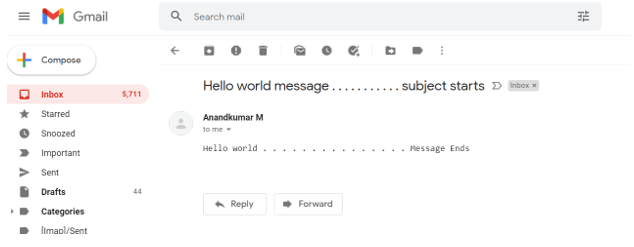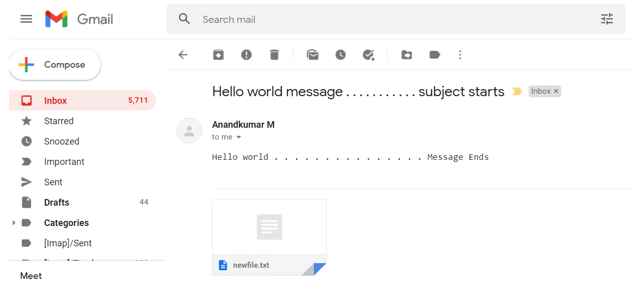Updated April 15, 2023
Introduction to Java Email
Sending emails through the java process is a simple and easy achieve the process. The process is an instant process, two mandatory items for java based email process are JavamailAPI and JAF framework. These are the two major sections to raise an email in java. These sections make the email raising process a simpler one in java based applications. Both Java mail API and JAF can be downloaded from the java standard website. An smtp server can also be used for sending emails. This SMTP server usage is an alternate method of email generation. Installing and using the SMTP servers like podcast server and apache James server is an alternative way for the same.
Steps in Java Sending Email
The key steps in sending the email are as follow,
1) Retrieval of the session object.
2) Compose the message which is intended to be sent.
3) Sending the message.
Let’s discuss each of these steps in detail, the first step of retrieval of the session object is responsible for pulling the session-based object. Every session which is been created may have an object associated to it. These objects will be tightly coupled with the information associated to the session. In order to retrieve the objects which are corresponding to a session the javax. mail.Session class needs to be used. This class has two different methods for retrieving the object instance details. So two built-in methods are used for retrieving the object instance details are Session. getdefaultinstance() method and the Session. getinstance() method. These are the two key methods for pulling the details of the associated object. To retrieve the session object itself any among the below methods can be used for such cases,
| s.no | Method details | Description |
| 1 | public static Session getDefaultInstance(Properties p) | default session value will be returned |
| 2 | public static Session getDefaultInstance(Properties p,Authenticator a) | default session value will be returned |
| 3 | public static Session getInstance(Properties prop) | Value associated to the new session will be returned |
| 4 | public static Session getInstance(Properties prop,Authenticator a) | Value associated to the new session will be returned |
Compose of the message: This is the very critical step to consider in this process. The step involves the process of formulating the original intended message from the source. So since this section deals with the original message, this is a very critical section to consider. For the composting process to happen the javax.mail.message is used. This class allows to sophisticatedly frame the message. This class is on the abstract level of operations so the sub-class of the same is called the javax.mail.internet.MimeMessage is more specifically used for this process. The session and the message associated will be piled up using the below segment of the code. So this code is used for combining the message and session details MimeMessage message=new MimeMessage(session);
Sending the message: The last process in this section is to send the message. The javax. mail. Transport class is used for this purpose. The intention of this class is to trigger the process of sending the message. So to be specific the process of sending the message can be very specifically attained by means of the javax. mail.transport message in specific. From a coding perspective the code snippet of Transport. send(message); is used exactly for this process.
| No. | Method | Description |
| 1 | public static void send(Message m) | The given method is used for sending the message. So transport of the message can be achieved by means of this method. |
| 2 | public static void send(Message m, Address[] address) | For sending the message to one specific address this method is used. |
Javax Mail Program Steps
Code:
import java.util.*;
import javax.mail.*;
import javax.mail.internet.*;
import javax.activation.*;
public class Initiateemail {
public static void main(String [] args) {
// email id of the recipient has to be mentioned in this field
String to = "[email protected]";
// email id of the sender needs to be mentioned here
String from = "[email protected]";
// Assuming you are sending email from localhost
String host = "localhost";
// All details associated to the property are mentioned here
Properties prop = System.getProperties();
// this is the step were the property setup can be eastablished
prop.setProperty("mail.smtp.host", host);
Session ses = Session.getDefaultInstance(prop);
try {
// onject associated to the message is initiated here
MimeMessage mess = new MimeMessage(ses);
// header details are decided and set here.
mes.setFrom(new InternetAddress(from));
// header field details are created here
mes.addRecipient(Mes.RecipientType.TO, new InternetAddress(to));
// subject details of the message are given here
mes.setSubject("Hello world message . . . . . . . . . . . subject starts ");
// Actual message of the email is given here
message.setText("Hello world . . . . . . . . . . . . . . . Message Ends");
// transport object is used for initiating the message
Transport.send(mes);
System.out.println("message has been sent successfully . . . . . ");
} catch (MessagingException mex) {
mex.printStackTrace();
}
}
}Output:
JavaMail Send Attachment in Email
Code:
import java.util.*;
import javax.mail.*;
import javax.mail.internet.*;
import javax.activation.*;
public class SendEmail {
public static void main(String [] args) {
String to = "[email protected]";
String from = "[email protected]";
String host = "localhost";
Properties prop = System.getProperties();
prop.setProperty("mail.smtp.host", host);
Session ses = Session.getDefaultInstance(prop);
try {
MimeMessage mess = new MimeMessage(ses);
mes.setFrom(new InternetAddress(from));
mes.addRecipient(Mes.RecipientType.TO, new InternetAddress(to));
mes.setSubject("Hello world message . . . . . . . . . . . subject starts ");
message.setText("Hello world . . . . . . . . . . . . . . . Message Ends");
mp.addBodyPart(mbp);
mbp = new MimeBodyPart();
String fl = "newfile.txt";
DataSource src= new FileDataSource(fl);
mbp.setDataHandler(new DataHandler(src));
mbp.setFileName(filename);
mp.addBodyPart(mbp);
messetContent(mp );
Transport.send(mes);
System.out.println("message has been sent successfully . . . . . ");
} catch (MessagingException mex) {
mex.printStackTrace();
}
}
}Output:
Conclusion
The article explains on how the java email messages can be setup and what are the classes involved in setting the email messages also it describes the program for sending an email and also to send an email with a file attached to it.
Recommended Articles
This is a guide to Java Email. Here we discuss the Overviews, Steps in Java Sending, methods, examples with code implementation. You may also have a look at the following articles to learn more –








